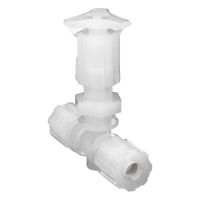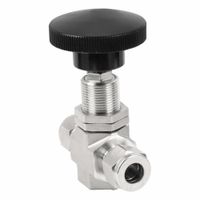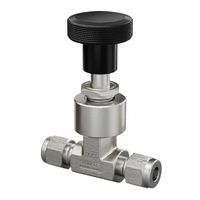Call +(254) 703 030 000 / 751 483 999 / 721 704 777
- Home
- Plumbing
- Plumbing Valves
- Throttling Valves
- Needle Valves
Frequently Asked Questions
What is a needle valve and how does it work?
A needle valve is a type of valve used to precisely control the flow of fluid. It features a small, tapered, needle-like plunger that fits into a conical seat. This design allows for fine adjustments to the flow rate, making needle valves ideal for applications requiring precise flow control, such as in gas chromatography, fuel regulation, and hydraulic systems.
The operation of a needle valve involves turning a threaded stem, which moves the needle in and out of the seat. When the needle is fully inserted into the seat, the flow is completely shut off. As the needle is gradually withdrawn, the flow path opens, allowing fluid to pass through. The tapered design of the needle and seat provides a gradual increase in flow area, enabling precise control over the flow rate.
Needle valves are typically used for low flow rates and are not suitable for high-flow applications due to their small orifice size. They are often made from materials like brass, stainless steel, or plastic, depending on the application and the type of fluid being controlled.
In summary, a needle valve is a precision device used to regulate fluid flow with high accuracy. Its design allows for fine adjustments, making it essential in applications where precise flow control is critical.
What are the main applications of needle valves?
Needle valves are precision-engineered devices used to control the flow of fluids in various applications. Their main applications include:
1. **Flow Control**: Needle valves provide precise control over fluid flow rates, making them ideal for applications requiring fine adjustments, such as in laboratory settings or chemical processing.
2. **Pressure Regulation**: They are used in systems where maintaining a specific pressure is crucial, such as in gas supply systems or hydraulic systems, to ensure consistent performance and safety.
3. **Isolation**: Needle valves can completely shut off fluid flow, serving as isolation valves in systems that require maintenance or emergency shutdowns without affecting the entire system.
4. **Sampling**: In industries like oil and gas, needle valves are used for sampling purposes, allowing small, controlled amounts of fluid to be extracted for analysis without disrupting the main flow.
5. **Instrumentation**: They are commonly used in instrumentation systems to control the flow to pressure gauges, sensors, and other measurement devices, ensuring accurate readings and protecting sensitive equipment.
6. **Fuel Lines**: In automotive and aerospace industries, needle valves regulate fuel flow in engines, contributing to efficient combustion and performance.
7. **Cryogenics**: Needle valves are suitable for cryogenic applications due to their ability to handle extreme temperatures and provide precise control over the flow of cryogenic fluids.
8. **HVAC Systems**: They are used in heating, ventilation, and air conditioning systems to regulate refrigerant flow, ensuring optimal system performance and energy efficiency.
9. **Medical Equipment**: In medical devices, needle valves control the flow of gases and liquids, such as in anesthesia machines or dialysis equipment, where precision is critical for patient safety.
10. **Research and Development**: Needle valves are essential in R&D labs for experiments requiring exact flow control, contributing to accurate and repeatable results.
How do you select the right needle valve for a specific application?
To select the right needle valve for a specific application, consider the following factors:
1. **Material Compatibility**: Ensure the valve material is compatible with the fluid or gas to prevent corrosion or degradation. Common materials include stainless steel, brass, and PVC.
2. **Pressure Rating**: Choose a valve that can withstand the maximum pressure of the system. Check the pressure rating to ensure safety and performance.
3. **Temperature Range**: Select a valve that can operate within the temperature range of the application. Consider both ambient and fluid temperatures.
4. **Flow Rate**: Determine the required flow rate and select a valve with an appropriate Cv (flow coefficient) to ensure efficient flow control.
5. **Size and Connection Type**: Choose the correct size and connection type (e.g., threaded, flanged) to fit the existing piping system.
6. **Operation Type**: Decide between manual or automated operation. Manual valves are suitable for simple applications, while automated valves are better for remote or precise control.
7. **Leakage and Sealing**: Ensure the valve provides adequate sealing to prevent leaks. Consider the type of packing and seat design for optimal sealing performance.
8. **Regulatory Compliance**: Ensure the valve meets industry standards and regulations relevant to the application, such as ASME, API, or ISO.
9. **Maintenance and Durability**: Consider the ease of maintenance and the expected lifespan of the valve. Opt for designs that allow easy access for repairs and replacements.
10. **Cost and Availability**: Balance the cost with the required features and ensure the valve is readily available for timely installation.
By evaluating these factors, you can select a needle valve that meets the specific requirements of your application, ensuring reliability and efficiency.
What are the advantages of using needle valves in high-pressure systems?
Needle valves offer several advantages in high-pressure systems:
1. **Precise Flow Control**: Needle valves allow for fine adjustments of flow rates, making them ideal for applications requiring precise control. The needle-like plunger fits into a seat, enabling gradual opening and closing, which is crucial in high-pressure environments.
2. **Leakage Prevention**: The design of needle valves ensures a tight seal, minimizing the risk of leaks. This is particularly important in high-pressure systems where leaks can lead to significant safety hazards and operational inefficiencies.
3. **Durability and Reliability**: Made from robust materials like stainless steel, needle valves can withstand high pressures and temperatures, ensuring long-term reliability and reducing maintenance needs.
4. **Versatility**: Needle valves are suitable for a wide range of fluids, including gases and liquids, making them versatile for various high-pressure applications.
5. **Pressure Regulation**: They help in maintaining consistent pressure levels within the system, which is essential for the stability and efficiency of high-pressure operations.
6. **Compact Design**: Needle valves have a compact design, allowing them to be used in systems with space constraints without compromising performance.
7. **Reduced Cavitation**: The gradual opening and closing mechanism reduces the risk of cavitation, which can damage components and affect system performance.
8. **Safety**: By providing precise control and reducing the risk of leaks, needle valves enhance the overall safety of high-pressure systems.
9. **Cost-Effectiveness**: Their durability and low maintenance requirements contribute to cost savings over the valve's lifespan.
These advantages make needle valves a preferred choice for high-pressure systems across various industries, including oil and gas, chemical processing, and power generation.
How do you maintain and troubleshoot needle valves?
To maintain and troubleshoot needle valves, follow these steps:
1. **Regular Inspection**: Periodically check for leaks, corrosion, and wear. Ensure the valve operates smoothly without excessive force.
2. **Cleaning**: Disassemble the valve carefully, clean all components with a suitable solvent, and remove any debris or buildup. Ensure the valve seat and needle are free from contaminants.
3. **Lubrication**: Apply appropriate lubricant to the stem and threads to ensure smooth operation. Avoid over-lubrication, which can attract dirt.
4. **Seal Replacement**: Inspect seals and gaskets for wear or damage. Replace them if necessary to prevent leaks.
5. **Reassembly**: Carefully reassemble the valve, ensuring all components are correctly aligned and tightened to the manufacturer's specifications.
6. **Testing**: After reassembly, test the valve for leaks and proper operation. Use a pressure test to ensure it holds the required pressure without leaking.
7. **Troubleshooting**:
- **Leakage**: Check for worn seals or damaged seats. Replace as needed.
- **Stiff Operation**: Inspect for dirt or corrosion on the stem or threads. Clean and lubricate.
- **Inconsistent Flow**: Ensure the needle and seat are not damaged or misaligned. Adjust or replace if necessary.
- **No Flow**: Verify the valve is not blocked by debris. Clean the internal passages.
8. **Documentation**: Keep records of maintenance activities, including inspections, repairs, and replacements, to track the valve's condition over time.
By following these steps, you can ensure the reliable operation of needle valves and address any issues promptly.
What materials are needle valves typically made from?
Needle valves are typically made from a variety of materials, chosen based on the application, fluid type, pressure, temperature, and environmental conditions. Common materials include:
1. **Stainless Steel**: Offers excellent corrosion resistance, strength, and durability, making it suitable for high-pressure and high-temperature applications. Common grades include 304 and 316 stainless steel.
2. **Brass**: Known for its good corrosion resistance and machinability, brass is often used in low to medium pressure applications, particularly where the fluid is non-corrosive.
3. **Carbon Steel**: Provides strength and is cost-effective for applications where corrosion resistance is not a primary concern. Often used in oil and gas industries.
4. **Monel**: A nickel-copper alloy that offers excellent corrosion resistance, especially in marine and chemical environments. Suitable for handling corrosive fluids.
5. **Hastelloy**: A nickel-molybdenum alloy known for its high corrosion resistance, particularly in oxidizing and reducing environments. Used in chemical processing industries.
6. **PVC (Polyvinyl Chloride)**: Used for low-pressure applications involving corrosive fluids, as it offers good chemical resistance and is lightweight.
7. **PTFE (Polytetrafluoroethylene)**: Known for its excellent chemical resistance and non-reactivity, PTFE is used in applications involving highly corrosive fluids.
8. **Bronze**: Offers good corrosion resistance and is often used in marine applications.
9. **Inconel**: A nickel-chromium alloy that provides high strength and corrosion resistance at elevated temperatures, suitable for aerospace and chemical processing.
10. **Titanium**: Known for its high strength-to-weight ratio and excellent corrosion resistance, especially in seawater and aggressive chemical environments.
The choice of material depends on the specific requirements of the application, including the type of fluid, operating pressure, temperature, and environmental conditions.
How do precision metering needle valves differ from standard needle valves?
Precision metering needle valves differ from standard needle valves primarily in their design and functionality, which are tailored for applications requiring high accuracy and control over fluid flow.
1. **Design and Construction**: Precision metering needle valves are engineered with finer threads and more precise machining to allow for minute adjustments in flow rate. This contrasts with standard needle valves, which have coarser threads and are designed for general flow control without the need for high precision.
2. **Flow Control**: Precision metering valves provide superior control over flow rates, enabling users to achieve very low flow rates with high accuracy. This is essential in applications such as laboratory experiments, chemical dosing, and instrumentation where precise flow measurement is critical. Standard needle valves, on the other hand, are suitable for applications where such precision is not necessary.
3. **Resolution and Sensitivity**: The resolution of a precision metering valve is higher, meaning it can make smaller incremental changes to the flow rate. This sensitivity is achieved through a more refined needle and seat design, allowing for better control over the flow compared to standard needle valves.
4. **Applications**: Precision metering needle valves are used in industries where exact flow control is crucial, such as pharmaceuticals, biotechnology, and analytical instrumentation. Standard needle valves are more commonly used in general industrial applications where precise flow control is not as critical.
5. **Cost**: Due to their specialized design and manufacturing process, precision metering needle valves are typically more expensive than standard needle valves. This cost is justified by the enhanced performance and accuracy they provide in critical applications.
In summary, precision metering needle valves offer enhanced accuracy, control, and sensitivity compared to standard needle valves, making them suitable for applications requiring precise flow regulation.


